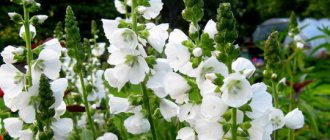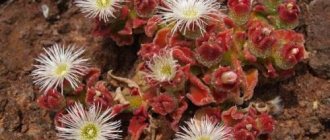The unusual centranthus plant has medium height and spectacular inflorescences. It has become quite widely used in landscape design, and is also often used when creating flower beds. Kentranthus is part of the Valerian subfamily, which is why people often call it “red valerian”. But unlike ordinary valerian, this plant is not a medicinal plant. This flower comes from the Mediterranean, and therefore for normal growth it needs sandy, light soil, as well as a large amount of light and heat.
Botanical description and homeland of the plant
Centranthus is a perennial herbaceous plant of the Valerian family; it does not have any medicinal properties.
The flower has attracted the attention of gardeners due to its originality, double wave of flowering, ease of propagation and ease of care. Originally from the Mediterranean, found in Portugal. It prefers to grow on sandy soils, likes bright lighting and warmth, but takes root well in central Russia. The fibrous root system is located close to the soil surface. The herbaceous stems are highly branched and form lush bushes up to 0.9 m high and 0.6 m wide. The entire perimeter of the stems is covered with pairs of oblong leaves of a grassy green or bluish hue. The basal leaves have short petioles, the rest are sessile.
When does centranthus bloom?
The tops of the shoots are crowned with oblong panicles of inflorescences. The small corollas consist of an oblong tube, cut at the tip into 4 lower equal-sized petals and one large upper petal; a long stamen emerges from the center. The color of the flowers is soft pink, muted red, burgundy. The first flowering is observed in June-July, then the seeds ripen, and the second wave of flowering occurs in August-September and the seeds appear again.
Growing centranthus from seeds
Centranthus seeds photo
Sowing in the ground
This method is the simplest; in addition, centranthus gives abundant self-seeding. Sow in open ground in spring at the end of April or autumn in September. In order for the small winged seeds to germinate, they are not buried in the soil. Simply dig up the area, remove weeds and break up clods of earth, distribute the seeds over the surface and cover with a rake. Mulch winter crops with a layer of dry leaves. If necessary, thin out the seedlings in the spring; you can use the seedlings as seedlings.
Growing seedlings
Centranthus from seeds photo seedlings
If winters in your region are frosty, it is advisable to grow centranthus seedlings.
- We sow the seeds in March in wide boxes with a sand-peat mixture. We simply distribute the seeds over the surface, as if adding salt to a dish.
- Spray with a fine spray bottle, cover tightly with a transparent bag or piece of glass and place on a bright windowsill in a warm room.
- We ventilate the crops daily, repeat spraying as they dry out, and remove the cover when seedlings appear.
- As they grow, we thin out the crops, leaving the strongest shoots at a distance of 5 cm from each other.
- We carefully plant the grown plants in separate cups, 1-2 seedlings each.
- We plant them in open ground in May, when the threat of return frosts has completely passed.
Contact domain owner
You can find other publicly available data on a domain name in the WHOIS section.
Naunet SP is one of the largest Russian domain name registrars. We offer the widest range of domain registration and maintenance services, website hosting services, as well as various additional services.
Working with Naunet SP you get:
- Service from the oldest registrar in the national zone .RU
- Domain registration in all major zones
- Service for selecting domain names by keywords
- Simple domain registration in three steps
- Convenient service management via a web interface
- Managing services from a mobile device
- 24/7 technical support with call tracking system
- Wide range of payment methods
- Direct deposit of funds directly to the registrar
- Modern Administrator protection against spam
- Protection of the Administrator’s personal data
- Protection against domain name theft
- Registrar professional activity insurance
- Secure online transfer of domain names
- Domain store
- Full line of hosting services and additional services
- Domain Administrator paper certificate
- Free service "DNS - Basic"
- Passport verification at the request of the Administrator
- Free SMS notification about important domain operations
- Crediting the cost of domains when ordering other services*
- Discounts and Promotions
- Partnership programs
- Professional application programming interface (API) for service management
Vegetative propagation of centranthus
During the summer, cuttings can be rooted; bushes can be divided before the growing season begins in the spring or after flowering in the fall. More details about everything.
We cut cuttings from strong branches and stick them into loose, fertile soil. At this time, there is intense heat, so to maintain moisture, the cuttings need to be watered and covered with a glass jar or cut plastic bottle. It is advisable to transplant the young plant to a permanent place next spring.
Overgrown mature bushes are propagated by division. We carefully dig it up, use a shovel to cut it into several parts with rhizomes and stems, and immediately plant them.
After 3-4 years, the bush loses its decorative effect: at the base, some of the shoots become lignified and lose leaf cover, the inflorescences become loose. The problem can be solved by one of the methods of reproduction.
Growing bellflower
The dotted bell is a very decorative medium-sized (50-70 cm) plant. In nature, it lives in forests and bushes, so the agricultural technology for growing point bells is somewhat different from most other garden species. It is quite moisture-loving, requires regular moderate watering, and grows well in partial shade.
Natural forms grow strongly and can fill a fairly large area. To limit the growth of a bush, you can use, for example, a plastic flowerpot. Varietal plants are much less aggressive. The plant blooms in May-June, after which it loses its decorative effect and goes into a dormant state. Easily propagated by dividing clumps, root layering, natural forms - by seeds. Planting is done in early spring or after flowering, but this resilient species takes root well at any time of the year.
Planting centranthus and care in open ground
Centranthus ruber in the garden photo
Choosing a landing site
This heat-loving representative of the flora grows best in a sunny area, protected from the cold wind. A successful planting is in the local area or on the south side of the fence.
In lowlands and flooded areas, the rhizome will suffer from fungi and rot, so exclude such places for planting. If groundwater lies close to the soil surface, make a bed on a hill.
The soil needs to be nutritious and drained; in nature, centranthus grows on mountain slopes, so rocky areas are quite suitable.
How to plant
- Dig a hole slightly larger than the root system along with a lump of earth.
- It is advisable to throw a handful of sand and garden lime at the bottom.
- If the soil is depleted, mix the soil removed from the hole with humus.
- When planting, handle the roots carefully, fill the hole with soil, lightly compact it at the surface with your palms and water.
- Leave 40 cm between plants.
How to water
The rhizome is very afraid of dampness, so centranthus is quite content with natural precipitation; water it only during a prolonged drought.
Feeding
We feed three times a season: in early spring, to stimulate growth, we apply a complex mineral fertilizer with a high nitrogen content; during the period of inflorescence formation and at the beginning of flowering, you will need to support the plant with potassium-phosphorus fertilizer.
Trimming
After the first flowering, it is necessary to trim off the faded inflorescences to the first pair of leaves. To limit self-seeding, do the same after the second wave of flowering. Remove root growth regularly. If this is not done, the next year the plantings will spread beyond their territory.
Plant care
Kentranthus loves sunny places with no drafts. Such a plant will certainly decorate the area.
Planting requires fertile soil that allows air and water to pass through. It is important to drain the soil to prevent rot from forming.
Top dressing
Feed the plant once a month. To do this, you will need nitrogen fertilizers at the formation stage, and without nitrogen at the flowering stage. In the middle of summer, potassium and phosphorus are added to the soil.
Watering
Irrigate when soil is dry. Regular watering will cause spots to appear on the leaves. If spots remain after stopping constant watering, remove diseased leaves.
Regular pruning will help prevent canthranthus from growing. In autumn, cut off the stems, and cut off the flowers as they wilt.
Wintering centranthus
If the winters in your region are frosty, centranthus must be protected from the cold. In autumn, we trim the bush to the ground and mulch with dry leaves or peat. The plant is not as afraid of frost as it is of severe waterlogging of the soil during the thaw period.
Additionally, build a frame shelter using spruce branches or branches, cover the top with oilcloth, burlap or special non-woven material, which are fixed with stones. With the arrival of warm spring days, remove the cover so that the centranthus do not dry out.
Registration rules
Registration rules clause 5.9.
When the delegation established by the domain name administrator is terminated due to the expiration of the domain name registration, the registrar installs temporary DNS servers for the domain that redirect requests via the http protocol to the registrar's service website with information about the reason for the termination of delegation.
Registration rules clause 4.5.
The right to submit an application to renew a domain name registration remains with the previous administrator until the expiration of the preferential renewal period. The duration of the preferential renewal period is 30 days after the end of the registration period.
Registration rules clause 3.3.1.
The registrar has the right to accept applications for registration of domain names that are in the preferential renewal period (registration of vacated domain names). Domain name registration is carried out at the end of the preferential renewal period, unless the previous domain name administrator renews the domain name registration.
Below is public data on the domain name:
Kentranthus in landscape design
Kentranthus in landscape design photo
Cute bushes can transform a flower bed in an original way, especially if you select species and varieties with different flowering periods.
Centranthus with other flowers photo flower beds
It is better to reserve space for group planting; centranthus is perfect for creating flowering areas in ridges and rocky gardens.
Kentranthus scarlet, pink and white photo of landscape composition
It is used to decorate the edges of garden paths and dry slopes; charming flowers are planted near gazebos, on alpine hills, and in rockeries.
Kentranthus mix photo
In a mixborder, centranthus is successfully combined with bush sage, adonis and other perennials.
Centranthus and irises photo
An original combination with bearded irises; in spring it will bring bright colors and richness of color to your garden.
Centranthus border photo
Independent mixed plantings of varieties of different shades look very nice. The lush flowering of centranthus cannot be ignored.
Types and varieties of centranthus with photos and names
Centranthus ruber or red Centranthus ruber
Centranthus ruber var. coccineus
The meter-long bushes have a diameter of about 0.6 m. The stems are well branched and densely leafy. Scarlet flowers form a racemose inflorescence of a pyramidal or round shape.
Varieties:
- Coccineus - thanks to its bright pink flowers, the plant is popularly called crimson ringing;
- Albiflorus, Albus – snow-white flowers;
- Rosenrot – shade of purple-pink flowers.
Popular varieties:
- Raspberry ringing
- Raspberry evening
- Pretty Betty
Centranthus angustifolius
The second most popular type. At first glance it appears to be identical to Centranthus red, but this one has longer, tapered leaves.
Centranthus calcitrapa
The height of the bush is 10-30 cm. The fluffy pyramids of inflorescences have a pink-ashy tint. It blooms already in April and pleases with its beauty until the end of June.
Varieties
Breeders have bred many different species of this plant, thanks to which gardeners can easily choose the right plant for their site and combine it with other plants and varieties. Let's talk about several types of centranthus.
- It is known about Centranthus Rubera red that subspecies forms can have not only red color, but also white, pink or purple. The height of the bushes can reach 100 cm with a width of 60 cm. Thick leaf covering of centranthus Ruber with scarlet inflorescences of round or pyramidal shape.
Red centranthus: photo
- About Narrow-leaved centranthus, it should be said that it is often confused with Ruber. However, this fairly popular species, despite its similarity with the above variety, has its own distinctive feature in the shape of the leaves - pointed tips.
- Long-flowered centranthus, with its tall bushes and bluish leaves, has a distinctive feature - a whitish coating. Oval and lanceolate leaves have a blunt edge. This centranthus, unlike others, has rather large flowers. The fifteen-millimeter bud has a dark purple color.
- The main distinguishing feature of Valerian centranthus is its miniature size. The maximum height of the plant is 0.3 m. It begins to bloom in April and lasts until the end of the first summer month. Petals are pink or ash-red.
- The variety recently bred by breeders, Centranthus Raspberry Ring, has characteristic crimson-colored petals with ten-millimeter flowers. Branching bushes of centranthus Raspberry ringing with bluish leaves reach a height of 0.8 m with pyramidal inflorescences.
Centranthus crimson ringing: photo











